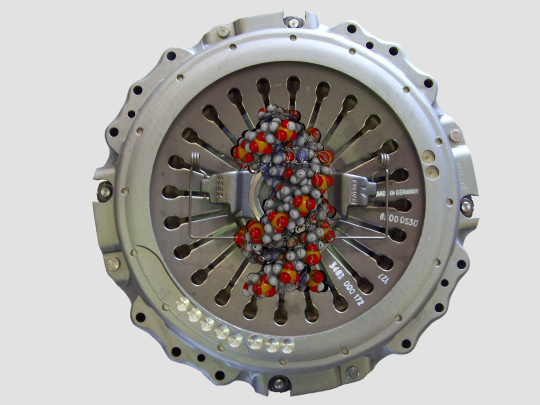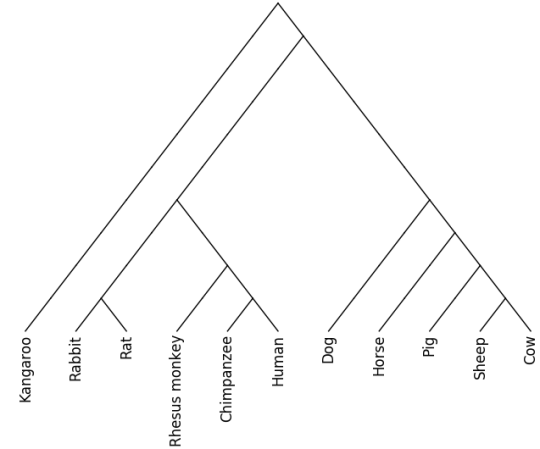
Image: Mash-up of wikimedia images, DNA and clutch.
Despite what creationists and Intelligent Design people tell you, the theory of evolution makes a remarkable number of predictions that have turned out to be correct. This is true for discoveries that postdate the discovery of evolution, such as plate tectonics, specific fossil finds and DNA. I want to discuss one in particular that is completely amazing, discussed by Richard Dawkins in The Greatest Show on Earth.
You sometimes hear it said that a creator could and would re-use elements of his creation if he or she wanted to do so. You might even expect it. So it should not come as a surprise to us that DNA is so similar across different species. This is just God parsimoniously re-using some of his best bits. Evolution says that the DNA is similar across different species because of their common descent. Don’t both theories explain the data just as well? It turns out not.
Let us start with an analogy with something that we know was created: the car. Suppose we had 10 different models (Honda Civic 2016, BMW 318i 2015, etc). We will suppose they are all modern and all have an internal combustion engine.

Image credit: istock/cosmin4000
Now consider five different components of the car, such as the clutch plate, the fuel injector, etc. For each of the five components, we have ten versions: one from each car. They perform similar functions in the different models, though there are some differences between the different versions.

Image credit: istock/Stason5ic
We can imagine drawing a kind of family tree for each car part. Unfortunately, we do not have access to the older models or the designers themselves, so we have to infer the family tree from the different parts. For example, two of these parts may be so similar, perhaps with just one small change, that we consider them siblings. Another two may have several differences, and would perhaps be third cousins. We could suppose that these all originated from a single, original invention, which engineers then tweaked for their own purposes, sometimes borrowing from one, sometimes from another. So in this way we could draw a family tree for how a specific part changed over time to become the ten versions that we see in the ten models of car that we are considering.
If you do this with all 5 components, you would expect to see 5 different family trees, where each tree represents how a specific component evolved to fit into the ten different cars. With something created, there would be no particular reason for the parts to have evolved the same way. The team working on the fuel system might borrow from one car, while the clutch plate team might borrow from another. They can mix and match to their hearts’ content. Something like this illustrative image:

This image is slightly deceptive, because the cars along the bottom are all ordered the same way (or equivalently, the tree branches do not cross). In reality that need not be so. Another nuance is that with just ten versions of a component we may not be able to get down to one single tree. But we could reasonably expect to get down to a relatively small number of candidate trees that would all be somewhat similar. So I will talk as though we could get down to a single tree for each component, and you can read that as a handful of candidate trees if you want to be pedantic.
With ten leafs there are about thirty four million different possible trees, and any one of them is plausible in the creationism scenario, so each different part would be expected to generate its own tree. You are essentially rolling a million-sided dice and expecting a different result each time. Nothing terribly special or surprising there. Creationism makes a very mundane prediction here.
What would be surprising is if any two of the five trees were the same. If would be mind-boggling if all five trees were the same. For example, we might say that the odds of the second tree being the same as the first are in the order of 1 in a million. The same with the third, fourth and fifth. So all five trees being the same would be something like 1 in 10²⁴, which is the same as saying that it would not happen by chance. It would be like rolling that million-sided dice and seeing the same number each time. With a million sides, if you saw any two of the trees being the same, you would look deeper and expect to find that the two components are related in some way, or something like that. It would not be chance: you would expect there to be a mechanism causing this relationship.
With this analogy as background, we can turn to biology. The analogy will be that instead of dealing with car models, we will consider ten different mammals (cow, sheep, pig, horse, dog, etc), and instead of dealing with car parts, we will consider five different genes (haemoglobin A, fibrinopeptide B, etc). These are somewhat like our car parts, in the sense that they have recognizably similar functions across our different species, but are subtly different in the details. They are also largely independent from one another, like our car parts (they work together, obviously, like our car parts, but are independent on the DNA string).
In fact, we can study these more accurately than car parts in many ways, because DNA sequences can be studied numerically and compared side-by-side and the mutations counted accurately. A string of letters is more susceptible to this kind of analysis than a comparison of two similar looking components. In the same way as it is easier to compare two different numbers than it is to compare two different photos.
We can roll a million-sided dice multiple times and get the same result!
The theory of evolution, formulated before we even discovered DNA, makes a very bold prediction. Basically all the trees implied by these different genes across the range of species will be the same. It says that we can roll a million-sided dice multiple times and get the same result each time!
I have stated this in an impressive way, but I need to add a couple of caveats which do almost nothing to dent this claim. Firstly, as I mentioned before, there is not going to be one single tree coming from each genes, but a collection of candidate trees. Out of the thirty four million possible trees, there will be several similar possibilities, which is why I have been saying it is a one in a million rather than one in thirty four million. Either way it is unlikely to be chance that is guiding it, especially if it happens many times. Secondly, there is a very small chance that a mutation will undo itself over time, so we would expect this to work almost always, but that there may be extremely rare examples where the tree we infer is not the one in a million. Such cases would require (beg for) closer scrutiny, and we might expect to be able to find an explanation. These do not really matter, though. The prediction remains incredibly bold.
As related in Dawkin’s book, a group of geneticists in New Zealand led by Professor David Penny did such a study in 1982. They used eleven mammals, meaning there are 655 million possible trees. There have been many similar studies since, resulting in similar confirmation of this incredible prediction. The details do not matter much, since the other studies have looked at other animals and other genes, but for the record Penny’s eleven animals were the: chimpanzee, cow, dog, horse, human, kangaroo, pig, rabbit, rat, rhesus monkey, and sheep; and the five genes were: haemoglobin A, haemoglobin B, fibrinopeptide A, fibrinopeptide B, and cytochrome C. The consensus of these different genes is shown in the following family tree:

This is the one in a million tree that was indicated separately by each one of the genes, and is part of a far, far bigger tree discovered in a similar way. They each had a one in a million chance that it would be this tree, and they all showed the same thing. It also broadly agrees with our previous ideas based on animal morphology, geographical distribution, and fossils, though this technique is far more rigorous than any of those. This is the tree on one face of a million-sided dice covered with many other trees. The creationist prediction that a creator would have re-used genetic material is a weak one, in the sense that it implies no correlation and so the dice would be expected to come up with different faces on each role. The evolutionary prediction is a strong one, implying that the same face will come up over and over again despite how unlikely that seems a priori. But that is what we see, over and over and over again. Each separate gene points to the evolutionary tree of life. They are simply not independent as you would expect in the design scenario and as you expect to see in something like a car.
Now, I have said that this is compelling evidence for evolution, and so it is. I want to discuss what it really means though. It is not “proof” for evolution, in the sense that no scientific theory is ever proved. It does disprove the specific version of creationism as stated, but no doubt creationists will simply rescue this with an ad hoc explanation for why the creator choose to do things this way. This will be an addition that explains why the creator appears as though he is not there at all, or postulates a link of some sort. At a certain point, it is more parsimonious to assume that it is what it looks like: constrained to a particular tree by their common descent. By way of comparison, I could say that I have a Rolls Royce outside, but that every time someone comes by, or I want to drive it, Martians remove it. This explains the on-going lack of evidence for the Rolls Royce, but it is better explained by its simple non-existence.
So it is not “proof”. But it is as compelling as the theory of gravity, or the quantum theory, or the theory of thermodynamics. These theories also cannot be “proven”, though they could theoretically be disproven. However, we do not expect these theories to be wrong, because they have made so many accurate predictions, and never been falsified (though they have been refined, for example, Newtonian gravity is restricted to certain conditions, and General Relativity is more generally applicable outside of those conditions). We now have confidence in them as theories. We believe that if we landed on Pluto, gravity would hold us there in a predictable way. No-one seriously doubts that, but this certainty is not assumed or given or part of a belief system. It is wrestled out of nature through a long history of predictions and experiments. It is the same with evolution.
The other day my 8 year old daughter came to me and said that she had a theory for how gravity worked, which she explained to me. I said to her: “Okay. How can we disprove it?” She was shocked. She wanted to prove it, not disprove it! I told her to suppose that I handed her an egg and told her it was incredibly strong. How would she check? Would she carefully place it in an egg box and treat it delicately? Or would she hit it with a baseball bat? The only way to know how strong it is, is to try to break it. That is what science does, and that is how scientists become convinced that something is true. Evolution is not accepted for any other reason than that it makes predictions that explain the data. Looked at honestly, the creationist notion that a creator re-used genetic components should be rejected on the same basis.